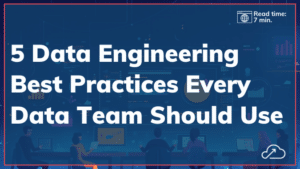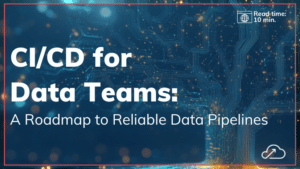Why Python for Data Engineering?
1. Interpretive Nature
- Immediate Execution: Python code runs directly through the interpreter, eliminating the need for a separate compilation step. This means developers can write, test, and debug at a faster pace.
- Platform Independence: With an interpreter for a specific platform, Python code can typically run without changes. This supports the notion: “Write once, run anywhere.”
- Dynamic Typing: Variables in Python are checked at runtime, allowing types to be flexible and change dynamically, speeding up initial development.
- Quick Iteration: The immediate feedback provided by Python lets developers experiment and adjust their approach efficiently, essential for data engineers fine-tuning processing techniques.
- Streamlined Development Cycle: The absence of compilation reduces the time between writing and executing code, making the overall development process more efficient.
2. Vast Libraries and Packages
- Data-Centric Libraries: Python has purpose-built libraries like Pandas, NumPy, and Scikit-learn, tailored for data manipulation, analysis, and machine learning, streamlining data engineers’ workflows.
- Plug-and-Play: Many of these libraries are designed to be integrated seamlessly, reducing development time and increasing compatibility across tasks.
3. High Performance
- Speed & Reliability: At its core, Python is designed to handle large datasets swiftly, making it ideal for data-intensive tasks.
- Integration with Spark: When paired with platforms like Spark, Python’s performance is further amplified. PySpark, for instance, optimizes distributed data operations across clusters, ensuring faster data processing.
- Extensibility: Python can be integrated with C or C++ for tasks that require an additional performance boost, making it versatile in handling a broad range of computational challenges.
4. Broad Adoption and Extensive Support
- Vast Online Resources: Python’s popularity means there’s a plethora of online tutorials, forums, and documentation available. Data engineers can often find solutions to common issues or leverage existing code snippets, making development smoother.
- Active Community: The active Python community continuously contributes to its growth, ensuring that the language remains relevant and up-to-date.
Python for Data Engineering Versus SQL, Java, and Scala
When diving into the domain of data engineering, understanding the strengths and weaknesses of your chosen programming language is essential. Here’s how Python stacks up against SQL, Java, and Scala based on key factors:
Feature
Python
SQL
Java
Scala
Performance
Offers good performance which can be enhanced using libraries like NumPy and Cython. Its versatility means you can optimize according to the task.
Exceptional at data retrieval and manipulation within RDBMS. It's specialized for database querying.
Known for high performance, especially when leveraging the Just-In-Time compiler.
Being JVM-based, it often surpasses Python in performance, especially in big data scenarios.
Typing
Dynamically typed, but can use type hints.
Operates on a well-defined schema with distinct data types.
Statically typed, requiring type definition upfront.
Statically typed with the advantage of type inference.
Interpreter / Compiler
Interpreted
Executed by a database engine, interpreting and executing SQL statements.
Compiled language that produces bytecode for the JVM.
Compiled, targeting the JVM.
Ease-Of-Use
Celebrated for its concise and clear syntax.
Declarative and straightforward for database tasks.
While powerful, it's more verbose than Python.
Offers a concise syntax but combines functional and object-oriented paradigms which can be challenging.
Ecosystem
Boasts a wide-ranging ecosystem suitable for diverse tasks.
Its ecosystem revolves around database management and querying.
Has a rich ecosystem, especially prominent in enterprise settings.
Strong especially in big data, with tools like Apache Spark.
Flexibility
Extremely flexible and adaptable across a multitude of domains.
Primarily tailored for database tasks.
Versatile but may need more boilerplate.
Unique flexibility due to its merging of functional and object-oriented approaches.
Learning Curve
Widely considered as one of the more approachable languages.
Initial learning is steep but mastering specific constructs is straightforward
A steeper curve due to its rigorous object-oriented nature.
Its hybrid programming approach makes the curve somewhat steeper.
Community Support
Broad community with countless resources.
Extensive support, particularly within distinct RDBMS communities.
Mature community, majorly in enterprise circles.
Growing, particularly robust in the big data domain.
Python for Data Engineering Use Cases
Data engineering, at its core, is about preparing “big data” for analytical processing. It’s an umbrella that covers everything from gathering raw data to processing and storing it efficiently. Python, given its flexibility and the vast ecosystem, has become an instrumental tool in this domain. Here are some examples of how Python can be applied to various facets of data engineering:
Data Collection
import requests
response = requests.get('https://api.weatherapi.com/v1/current.json?key=YOUR_KEY&location=London')
weather_data response.json()
print(weather_data['current']['temp_c'])
Data Transformation
import dask.dataframe as dd
data = dd.read_csv('large_dataset.csv')
mean_values = data.groupby('category').mean().compute()
Data Storage
import psycopg2
conn = psycopg2.connect(dbname="mydb", user="user", password="password", host="localhost")
cursor = conn.cursor()
cursor.execute("INSERT INTO table_name (column1, column2) VALUES (%s, %s)", ("value1", "value2"))
conn.commit()
Data Streaming
from pyspark.streaming import StreamingContext
from pyspark. import SparkContext
sc = SparkContext(appName="TwitterData")
ssc = SteamingContext(sc, 10) # 10-second window
stream = ssc.socketTextStream("localhost", 9092)
tweets = stream.flatMap(lambda line: line.split(" "))
hashtags = tweets.filter(lambda word: word.startswith('#'))
hashtags.pprint()
Data Integration
import pandas as pd
data_csv = pd.read_csv('data1.csv')
data_excel = pd.read_excel('data2.xlsx')
combined_data = pd.concat([data_csv, data_excel], ignore_index=True)
Big Data Frameworks
from.pyspark.sql import SparkSession
spark = SparkSession.builder.appName("BigDataProcessing").getOrCreate()
data = spark.read.csv("big_data.csv")
data.groupBy("category").count().show()





